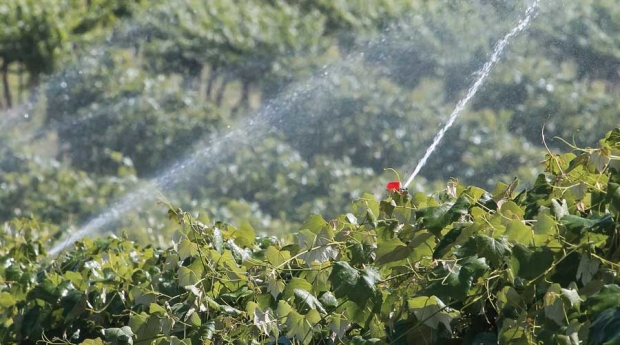
The key times in the growing season when water is most critical to grapevine development are in the spring, at bloom, during fruit set and during compound bud development. (TJ Mullinax/Good Fruit Grower)
Low water years pose additional challenges for Pacific Northwest Concord growers, who are already dealing with low prices.
However, there are steps growers can take to ensure their vineyards remain healthy — even in a tight water year — at the most critical points during the season.
The first step is to know as much as possible about the vineyard’s soil, according to Jason Stout, a post-doctoral research assistant at Washington State University’s Irrigated Agriculture Research and Extension Center in Prosser.
At the Washington State Grape Society’s annual meeting in November, Stout reminded growers that soil texture determines the field capacity and permanent wilting point in their vineyards — and the sweet spot for repeated irrigation throughout the season.
Field capacity (FC) is the total amount of water a soil can hold. Soil is typically at FC one to two days after a heavy rain or immediately after irrigation when no standing water is left on the soil surface.
Any water added above the FC will not stay in the root zone, but will drain due to gravity.
The permanent wilting point (PWP) is reached when water content is too low for the plant to remove water from the soil, or the water is too tightly bound by the soil to be extracted by the plant, and the plant cannot recover from the deficit.
The amount of water between FC and PWP is your plant-available water.
“You don’t want to apply above the field capacity, because that’s a waste. You lose that water,” Stout said. “And you want to know your permanent wilting point and the range at which you need to reapply water, which is typically when you reach 50 percent of the plant-available water.”
With Concords, unlike wine grapes, growers want to minimize stress levels as much as possible to maximize yields.
Taking a measurement of the soil moisture content as a way to estimate water usage/availability is definitely better than applying a set amount of irrigation weekly, Stout said.
Early in the season, growers on a set schedule may be overapplying, yet they may be underapplying water later in the season if it’s a particularly hot year.
Stout examined soil moisture availability at different times in the growing season on a drip-irrigated Concord vineyard — at the three to four leaf stage in the spring, at veraison and after final irrigation.
In the spring, the soil was at or near FC throughout the primary rooting zone for Concords, he said. This was due to overwinter precipitation and two to three early-season applications of irrigation.
However, because the vineyard was drip irrigated, the moisture was contained within 100 centimeters on each side of the vine row.
From bloom to veraison, Stout applied 25 percent less water to the vineyard in one treatment than the control, resulting in a decrease in available water over that period, he said, but the soil refilled again before final irrigation.
Stout reminded growers that there are key times in the growing season when water is most critical to grapevine development, and all occur pre-veraison:
—In the spring for bud burst and canopy establishment.
—At bloom to ensure adequate pollination.
—During fruit set to determine the number of berries.
—During compound bud development to ensure next season’s fruit production.
Also making that point: a 2011-2015 study highlighted by Dr. Markus Keller, WSU viticulturist.
The study covered a large span of growing degree days — a cool year in 2011, an average year in 2012, above-average temperatures in 2013 and 2014 and a hot year in 2015.
Seven drip irrigation regimes were tested at pre- and post-veraison points.
The study showed there was little or no difference to the vines when irrigation water was applied to replace 75, 100 or 150 percent of crop evapotranspiration. (Evapotranspiration is the process by which water is transferred from the land to the atmosphere by evaporation from the soil and other surfaces and by transpiration from plants.)
Only when water was reduced to about 50 percent evapotranspiration did the plant show significant water stress, Keller said.
Overall, that level of deficit irrigation in juice grapes reduced yield by about 14 percent, but only if the stress occurred before veraison.
“Applying less water from fruit set to the beginning of ripening is a key period of concern,” Keller said. “It’s less important to manage water post-veraison than we had thought. At that time Concord vines can tolerate a 50 percent reduction in water supply without suffering a loss in berry size, but it’s extremely important to manage water during fruit set.”
Keller said growers should not be afraid of drought conditions as long as they can manage big canopies with water supplies during the pre-veraison period.
“If you neglect to apply enough water at that time, you cannot compensate later by applying more water post-veraison. Berries will remain small at that point.”
However, Keller said, there was no effect on juice composition or cold hardiness during the changes from year to year. •
– by Shannon Dininny






Leave A Comment